Some marketers think never-ending blog content is the key to success. But focusing only on pushing out new blog content could take resources away from other types of content and on-page optimization that could impact your site’s SEO.
There’s no singular type of content that every organization should invest in. In most cases, a multi-pronged approach is preferable. Instead of focusing solely on blogging,you may want to explore whether content marketing without a blog better matches your audience, business offerings, and goals. In many cases, the work you do off-site will matter just as much (or maybe even more!) than what you post on your business blog.
How Much Does Blogging Really Matter?
Blog posts can be a great way to provide valuable information that’s optimized for search. That said, blogging isn’t the right choice for every company. However, all organizations should optimize written content for search to drive traffic and convert visitors.
Too often, businesses assume that blogging is the only option without reviewing the full spectrum of content types to choose from. Blogging does drive results for many businesses, but it’s not a universal medium every organization must adopt. There are plenty of tactics to improve SEO without a blog. (That’s not to say there isn’t tremendous value in a blog. Here’s how to start one.)
HubSpot reports that blogging is the third-most used form of content marketing, behind video and infographics. And yet, according to a 2020 survey by Lucid, 40% of people never read blogs.
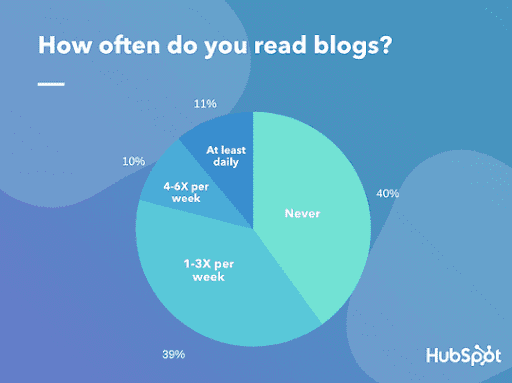
“Many businesses begin a blog with the belief that it will solve their marketing woes,” says Rebekah Radice, CMO of Post Planner. “Need more traffic? Check. Gain visibility? Check. Want a legion of loyal readers that hang on your every word? Sure…that’s easy. Or at least that’s what some believe.” Radice adds, “In reality, building a blog and a solid content marketing plan takes time and effort. And whether you have a blog or not, you can still create a content strategy.”
To drive links, quality traffic, search rankings, and conversions from search, every organization needs to create a content strategy. This strategy includes the types of written and visual content you’ll develop and share, where it will live, why you’re creating it, and how it will be distributed to the right audience.
For many organizations, blogging is a no-brainer. But that doesn’t mean all of your on-site content has to be published via blog posts.
4 Ways to Market Your Business Without a Blog
According to Radice, there are three elements to consider when developing an effective content marketing strategy for your company:
- Your audience’s likes, dislikes, wants and needs
- The struggles they face daily (and the solution you provide)
- How you’ll leverage content platforms (social, email, etc.) to spread your message
And while a company’s blog is often the chosen vessel for sharing this content, it’s far from the only one available. What’s more, there may be other, more effective ways to get your message across. Let’s discuss four major content options for strategically positioning a site in search with written content not found on your blog.
1. Develop In-Depth Product Pages and Landing Pages
In lieu of (or in addition to) a consistently updated content hub like a blog, you may want to focus on the creation of in-depth, copy-rich product pages and landing pages throughout your website.
The goal of a product page is to convince a browser to purchase the item if it suits their needs.
The inclusion of copy and any other form of content on a product page should never distract from driving a purchase – but if executed correctly, it can help drive additional visibility to the page in search, while promoting the product.
For example, the typical elements of a product page (like the product image, product description, pricing, specifications, etc.) should be featured prominently at the top of the page, while more in-depth written content is provided on the lower half (“below the fold”).
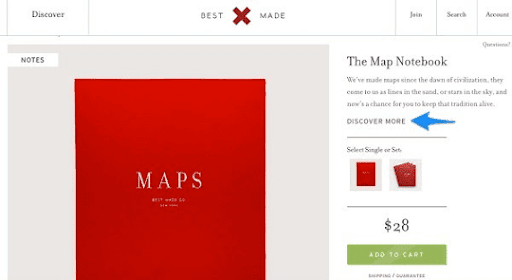
Best Made Company executes this strategy across their product pages by including the most pertinent information about their product at the top of the page; if a user clicks on the “Discover More” button or scrolls to the bottom of the page, they can view additional written content and a video related to the product.
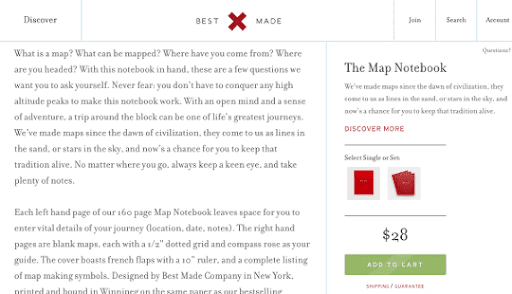
This in-depth information can include additional backstory around the creation of the product, examples of the product in use, FAQs, or videos that detail how the product can solve a user’s problems.
This additional content adds more context to a product page, benefitting your site in two ways:
- It allows customers to learn more about the product.
- It improves search engines’ understanding of the page.
If you sell specific products or services, consider experimenting with different formats of content-driven product pages to see what drives the most amount of search traffic visibility without reducing conversions.
Here are a few types of content-focused, in-depth product pages to consider:
- Product descriptions of 500+ words
- Product descriptions paired with multiple optimized images
- Video content showcasing products and their various uses
- Copy that includes links to related articles on the product and its uses
- Video content with transcribed text
- Content that includes a combination of images, in-depth copy, and video
Similar to the approach to product pages, the inclusion of copy or other forms of content on a landing page should not be at the expense of driving visitors to complete the desired conversion.
When creating campaign-specific landing pages or revamping existing pages, you’ll want to integrate additional copy, videos, or images that explain the value of filling out the form, downloading a resource, or completing a desired action.
For instance, WebDAM promoted a guide on a campaign-driven landing page and included additional text below the fold to convince visitors to convert and provide context for search engines.
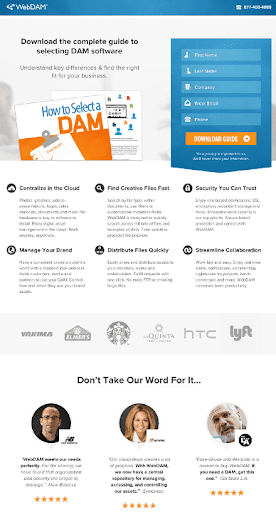
WebDam could have finished creating their landing page above the fold, but they instead included extra copy on the lower section of the page explaining the main benefits covered in the resource. You’ll also see logos from existing customers (which provide social proof) and client testimonials.
When developing landing pages, you’ll need to add more valuable written copy to a page without distracting visitors from converting.
Here are a few tips to help you add copy to a landing page:
- Stay consistent with the existing content already on the page
- Include the benefits of filling out the page’s signup form
- Summarize the contents of a guide, whitepaper, e-book, etc.
- Present a description of an included image or video
- Feature customer testimonials, endorsements, and other forms of social proof
Note: You don’t have to stuff as much copy as possible on a landing page or product page. Instead, identify opportunities across each type of page where adding copy can provide value to a customer and additional context for search engines.
2. Produce Content on Third-Party Platforms
Another method of reaching an audience without blog content on your own website is contributing content to third-party platforms with built-in distribution channels like social media and blogging sites.
While there are many third-party content platforms to consider, some of the most popular ones are:
- Medium
- Tumblr
Creating content for these channels allows organizations to still compete in search with relevant information related to their expertise and product offerings without having to maintain their own blog.
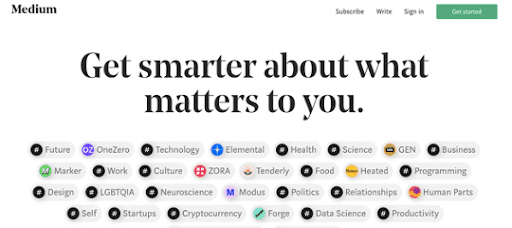
An additional benefit of sharing content on third-party platforms is that they already have a large built-in audience. The audience of a third-party platform increases the likelihood of viewership and interaction with content – something that a relatively new business blog might not have on its own.
A downside to sharing content on a third-party website is that links to the content won’t point to your website. Readers don’t have to navigate to your website to consume your content, so it may be tougher to convert readers to customers.
To address this issue, you’ll want to include relevant links within the content submitted to third-party platforms that point to related resources hosted on your website (like whitepapers, landing pages, etc.). You’ll also want to add a call-to-action at the end of any content shared on these third-party sites to drive traffic back to your website with a relevant offer. Not only can this potentially increase your website traffic, but it can also improve your site’s backlink profile. Even if the link is classified as a no-follow link, that diversification can still be a plus when performing an SEO backlink audit!
LinkedIn can be an especially effective option for many businesses, as the social network offers the ability to blog from any professional account. From there, you can easily share the content with your network.
“The Publisher platform on LinkedIn gives you an amazing opportunity to create content that can position you as a thought leader or expert, create greater visibility for you and your business, help you to better establish your brand, and generate engagement with your target market,” says LinkedIn expert Viveka von Rosen, owner of LinkedIntoBusiness.
According to Rosen, even if your organization does have a staff with strong writing skills, you can gather and curate content from others like:
- Quotes from other influencers and industry leaders
- Book reviews of industry titles
- Recorded and transcribed interviews with influencers and industry leaders
- Recorded and transcribed how-to videos
Sharing content in a short-form Facebook post is significantly different from sharing a full article on Medium, LinkedIn, or Tumblr.
To succeed with driving attention in search with short-form content shared on Twitter or Facebook, consistently use these platforms to build an audience. Cater content to the channel and ensure some of the content shared on these channels is evergreen.
And while the future of Twitter (or X) currently hangs in the balance, many have used it in the past to rank in search. When going this route, you can generate interaction with the content that lives on a website like a landing page, product page, or case study by tweeting about it and encouraging others to tweet about it, as well.
The more genuine engagement a content item gets from Twitter over time, the more likely Google will take those social signals into consideration and rank the resource accordingly.
“Twitter is a great platform for written content,” says Madalyn Sklar, Twitter Smarter podcast host and Twitter marketing coach and consultant. “While most people shrug at the thought of getting a quality message out in [a limited amount of] characters, you can actually do this in a series of tweets. It’s a great way to build up hype and anticipation.”
Using Twitter to impact the ranking of the non-blog content resources on a website requires consistent activity on the platform. It’s best to alternate your company’s tweets by including content from others with your own resources to build an audience over time.
When creating short-form content adapted for Twitter, consider covering one of these four focus areas with your organization’s tweets:
- Provide straightforward and immediately useful information
- Offer analysis on what a particular topic means
- Share a brief explanation of how this information applies to the target audience
- Occasionally add entertaining tweets to diversify the content being shared
After considering one of the four focus areas for company tweets, you can get inspiration for your posts from your existing on-site content or content from elsewhere on the web.
Some written content examples of what to tweet about might include…
- Quotes derived from your long-form content
- Interesting facts, figures, and statistics pulled from an on-site or gated resource
- Video, images, and GIFs that derive from or support your content
- Highlights of an influencer’s use of a resource
- A piece of content’s section headers or a brief list
- Bite-sized lessons from or benefits of a resource
It’s less common for a tweet or a Facebook post to itself rank in search than it is to have those posts influence your site rankings. But if it does happen, it’s best for that content to be evergreen, rather than timely.
Not all of the content you share on these platforms needs to be evergreen, but your long-term value will be higher if the majority of your content stays relevant for as long as possible. The magic formula for high-ranking social content? Create something that includes both timely, news-related insights supported by evergreen content.
3. Invest in PDF-Focused Content
There are three types of content that are most often delivered in PDF format: Whitepapers, ebooks, and case studies. Unfortunately, these kinds of content are often overlooked when organizations develop strategies to improve their search rankings.
PDF-focused content is usually more in-depth than a blog post or an article. It’s not meant to be skimmed; rather, it’s intended to be read thoroughly by prospects with a deeper interest in a company’s offerings or the subject matter at-hand.

“The difference between just a piece of content and content marketing is the destination,” says Michael Brenner, CEO of Marketing Insider Group and one of the leading voices in marketing today.
The destination or end goal of PDF-focused content is very different from a traditional blog post. It’s addressing customers at a deeper part of the marketing funnel, whereas blog posts are more focused on driving awareness of an idea, company, or product at the very top of the funnel.
Brenner argues that not knowing the distinction between different types of written content and how they impact a business shows a lack of commitment in content marketing – and one that will ultimately lead to the failure of a program.
“If a brand does not have a real focus and a true commitment, they shouldn’t bother with content marketing,” Brenner says.
Optimizing PDF content for search entails ensuring these documents are primarily text-based and have the ability to be crawled. PDFs certainly provide an opportunity to add a unique visual presentation of a company’s data and expertise, as long as the design of a document is not at the expense of including quality copy.
At minimum, you’ll want to include an enthralling title tag and meta description for any PDF document by updating its document properties within your PDF creator tool of choice.
Most PDF tools also feature an author field. Here, you’ll want to add the company’s name as the author of the content from the document’s properties. If the option is available, add keywords and tags if relevant keywords and/or tag fields exist.
You should also add a keyword-rich file name for the PDF, as this will become part of the document’s URL, which needs to be as SEO-friendly as possible.
Don’t neglect to link to other content internally within PDFs. Include keywords in the body copy and optimize all images included with alt tags.
To ensure PDFs aren’t downloaded and then reuploaded to another website with its links removed, you should also write-protect each document. That makes it far more difficult for any rogue actors to make their own edits to your work.
You may also want to consider repurposing some of these PDFs into HTML content. You can use the entire document (or excerpts of it) to build out a landing page, product page, etc. When turning PDFs into HTML, avoid any duplicate content issues to ensure these efforts with content are helpful and not hurtful to the company’s search profile.
Lastly, ensure the file size for PDF content is reduced to be as small as possible. A document with a large file size will take longer to load, which affects how the search engine crawls the item. It can also have a negative impact on a person’s experience with the content, which can affect your SEO results.
4. Repurpose Your Existing Content
Finally, you can get more mileage out of your existing written content by transforming it into new assets. There’s a secret every good writer and creative person knows, and it will change the way you market your business: You don’t need a new idea every time you create new content.

Leveraging your existing content to create new assets can speed up your development process while increasing your reach – and ultimately help you get the most bang for your buck.
Imagine you work for an accounting firm. A new state tax law goes into effect, so you decide to create a PowerPoint about the new law and do a presentation for your local chamber of commerce. Someone shoots a video of your presentation and you upload it on YouTube, allowing you to share it on your social networks and send it to your email subscribers. You then use the content to create a podcast episode and you design an infographic showing how the law affects your clients. All of your thinking, writing, and discussion about the issue inspires you to write an ebook about the law. You can then break down that ebook into smaller blog posts.
With any type of content you produce, think about how you can repurpose it into other forms of written content that gives your SEO a boost. Start with your most popular recent posts or evergreen posts and brainstorm how you might recycle that content into something else. You could:
- Turn a slideshow into an ebook
- Turn a video or podcast transcription into a series of Twitter quotes
- Turn a video into a slideshow with an in-depth summary
- Turn an ebook into a series of Medium posts that link back to the full ebook
- Turn a case study with lots of data into an infographic with a written summary or pertinent updates below
- Turn a slideshow into an explainer video with transcription
After transforming your first existing piece of content into something new, ask yourself if you could express it another way… and then another. This process takes ideas from the past and reworks them into something fresh and new with minimal effort.
Once you’ve gone through the repurposing process with content you already have, you’ll think about new ideas in a different way. Each idea can be used in multiple forms of written content beyond blogs, including video transcriptions, ebooks, and case studies. If you don’t yet have a blog but have other forms of content, you can start a blog by repurposing content into blog posts — or as content on third-party sources, as discussed above.
Do You Already Market Content Beyond a Blog?
What challenges does your company face when devoting time, effort, and resources to creating non-blog content? What types of content tend to drive results for your organization and why? We would love to hear about your experience with content marketing without a blog over on Twitter @DigitalCurrent.
If you have any questions on content strategy/planning or need help getting more traffic to your content, please reach out to Digital Current.


